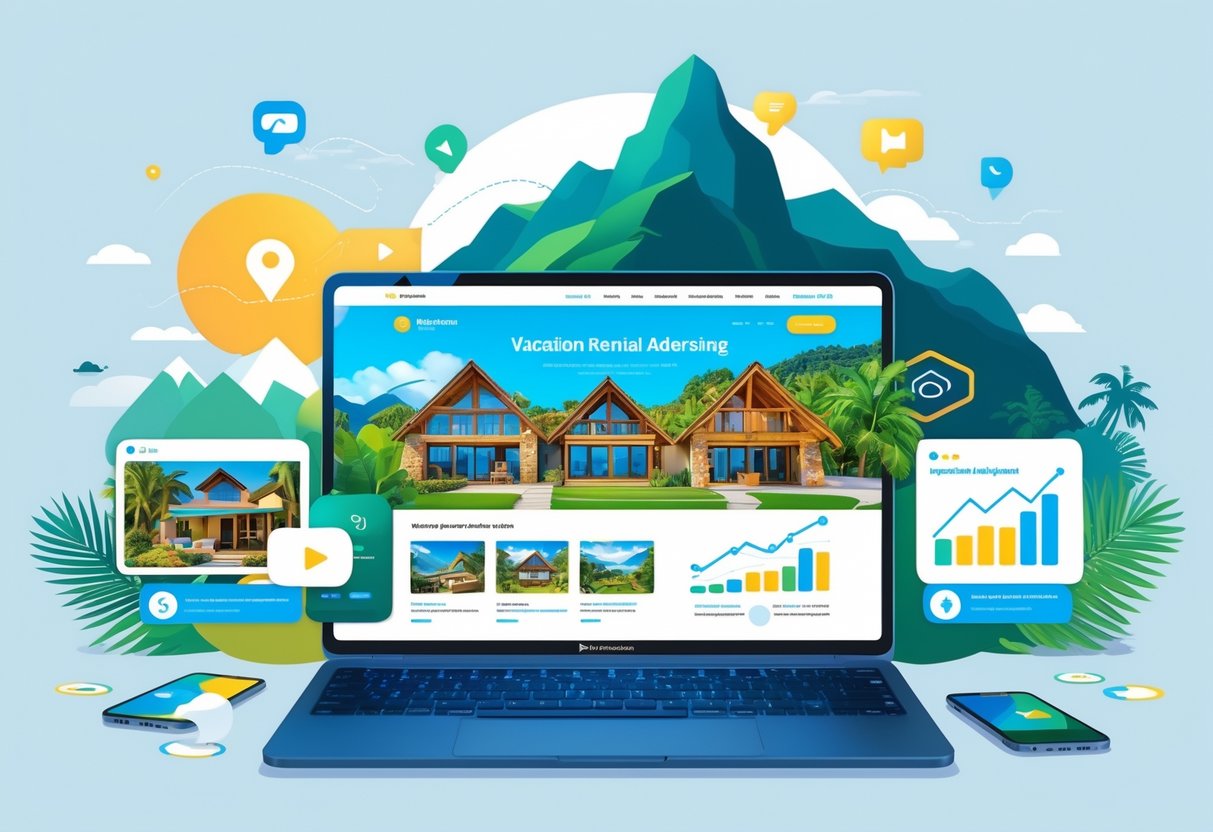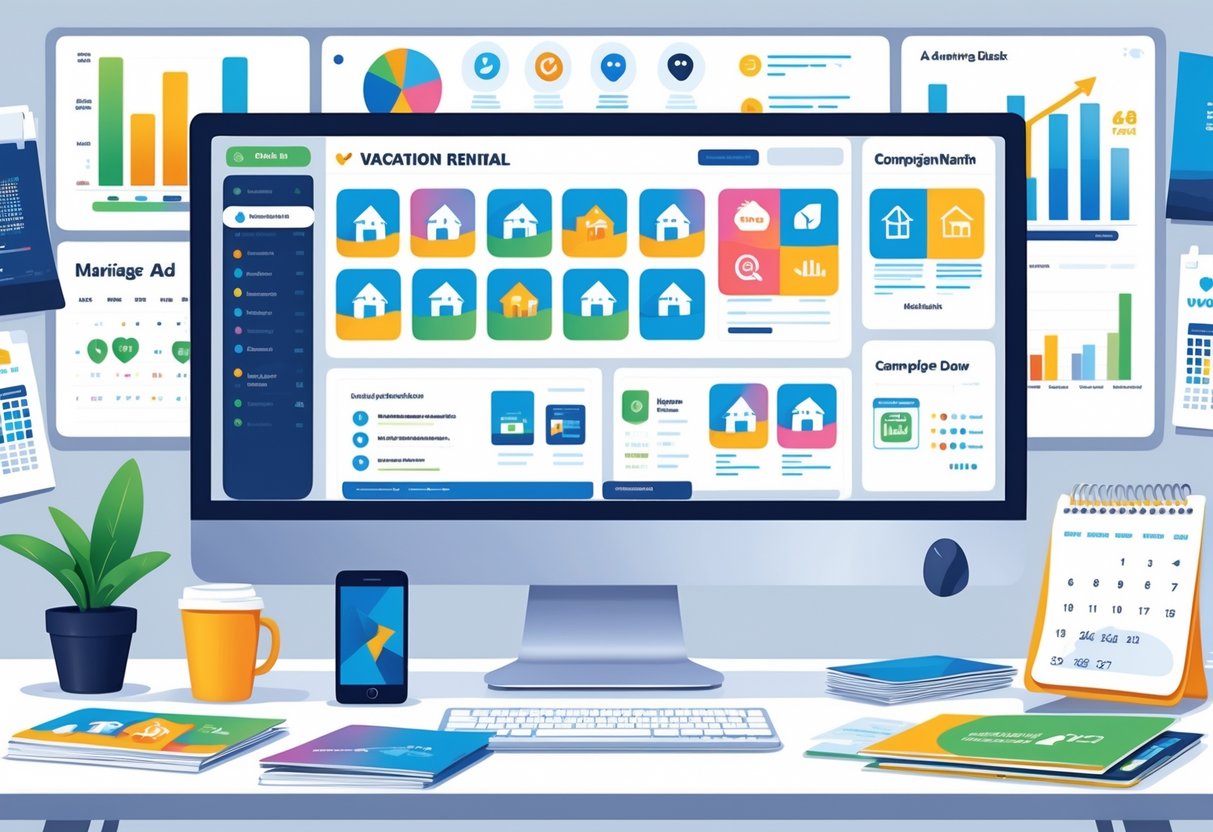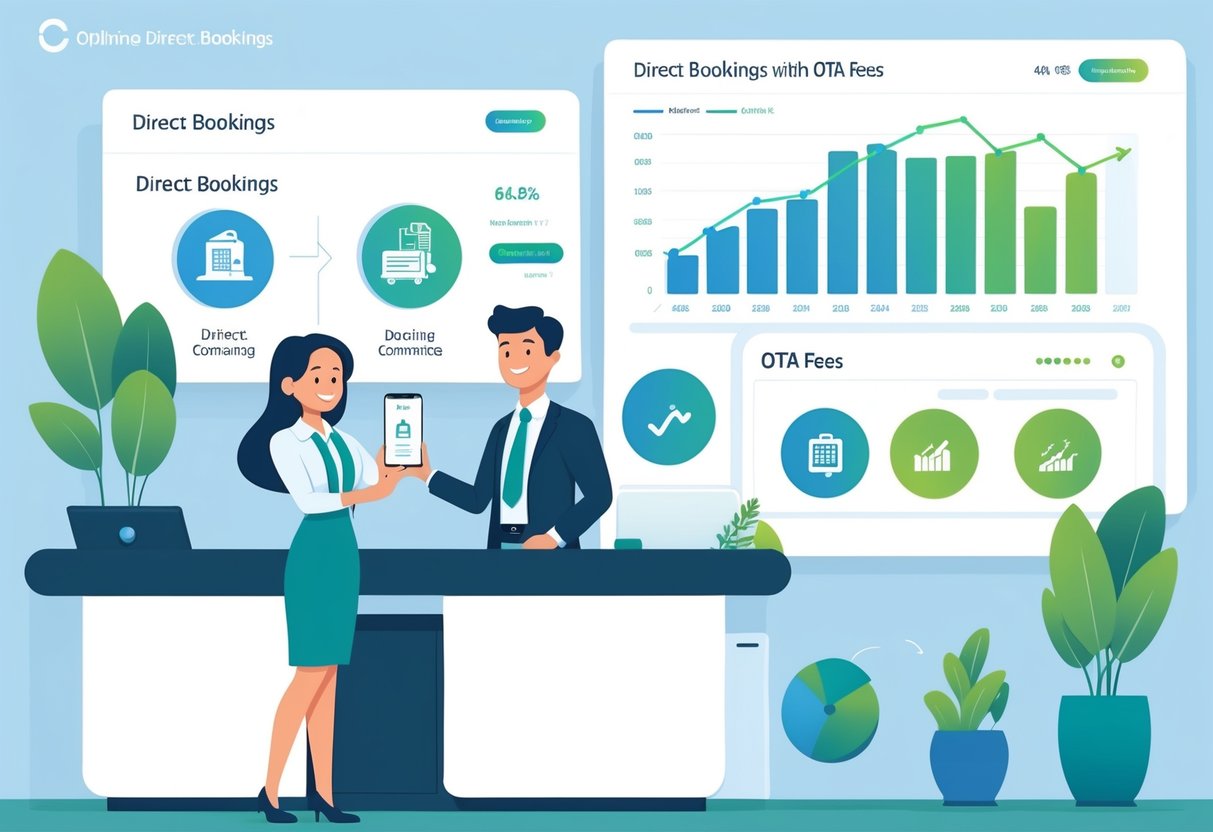Vacation rental owners deal with fierce competition these days. If you want guests and steady bookings, you really can’t ignore advertising anymore.
Even the most stunning properties can sit empty if nobody knows they exist. Meanwhile, your neighbor with a less impressive place but killer marketing fills up every weekend.

Successful vacation rental advertising means using several channels—think online travel agencies, social media, and direct booking sites—to reach as many potential guests as possible. Creating an eye-catching listing is step one, but you’ve also got to get your property on Airbnb, Vrbo, Booking.com, and put in some real effort on social media.
You need to figure out which strategies give you the best bang for your buck, while also building your brand for the long haul. Professional photography, strong listing descriptions, targeted social campaigns, and SEO all matter.
Key Takeaways
- List your property on multiple platforms and use great photos with punchy descriptions to attract guests.
- Social media marketing—Facebook, Instagram, all that—helps you reach more people and show off your place visually.
- Track your advertising results and tweak your campaigns based on what’s actually working.
Understanding Vacation Rental Advertising

Vacation rental advertising is all about using different strategies and platforms to get more guests and more bookings. The vacation rental market has gotten super competitive, so you can’t just list your property and hope for the best.
What Is Vacation Rental Advertising?
Vacation rental advertising means promoting your short-term rental on a bunch of platforms and channels. Owners use these tools to get their properties in front of the right people.
Effective vacation rental advertising usually includes listings on Airbnb, Vrbo, Booking.com, plus social media marketing, search ads, and direct website promotion.
You need pro photos, a description that actually sells, smart pricing, and messages that speak to your ideal guests. Highlight what makes your place special—location, amenities, whatever sets you apart.
Key advertising components:
- High-quality listing photos
- Detailed property descriptions
- Strategic pricing optimization
- Multi-platform presence
- Guest review management
Benefits of Effective Advertising
When you advertise your vacation rental well, you get more bookings and make more money. Properties with solid marketing show up higher in search results and get more guest inquiries.
You’ll see higher occupancy and can often charge more because your place looks more valuable. Plus, if you target the right guests, you’ll get better reviews and fewer headaches.
Primary advertising benefits:
- Higher search ranking positions
- Increased booking conversion rates
- Premium pricing opportunities
- Better guest quality
- Enhanced property reputation
Overview of the Vacation Rental Market
The vacation rental industry has exploded in the last decade—there are millions of listings now, all fighting for attention.
Competition is tough, and hotels are in the mix too. Platform algorithms push listings with great photos, full info, and positive reviews to the top.
If your advertising isn’t up to scratch, your property can disappear into the search result abyss, no matter how nice it is.
Market saturation is different everywhere. Tourist hotspots are the most crowded, and demand changes with the seasons, so you have to keep your advertising flexible.
Market characteristics:
- Millions of active listings worldwide
- Increasing competition from new properties
- Algorithm-driven booking platforms
- Seasonal demand variations
- Rising guest expectations for quality
Key Platforms for Vacation Rental Advertising

To get bookings, you need to pick the right mix of platforms. Big online travel agencies pull in most of the bookings, but direct booking helps you keep more of your earnings and build real relationships with guests.
Listing on Online Travel Agencies (OTAs)
Airbnb, Vrbo, and Booking.com are the heavy hitters for vacation rentals. These sites have huge reach, so you pretty much have to be on at least one.
Airbnb is all about unique experiences and draws younger travelers looking for something authentic. They emphasize host interaction and local flavor.
Vrbo focuses on families and groups who want the whole place to themselves. These guests often stay longer.
Booking.com covers both business and leisure travelers, with tons of options and filters. It’s especially popular with international guests.
To stand out, you need pro photos and a killer description. Each platform has its quirks and different ways of ranking properties.
You’ll need to price competitively, reply quickly, and keep your review scores high to succeed.
Niche and Local Listing Sites
Smaller, specialized sites can help you reach guests you might miss on the big OTAs. They’re often cheaper and more targeted.
Pet-friendly sites like BringFido are great if you allow animals—these guests often stay longer and are willing to pay more.
Luxury rental sites (think Luxury Retreats) cater to high-end travelers. You’ll pay higher commissions, but the nightly rates are worth it.
Local tourism boards and destination marketing organizations sometimes have their own listings. These attract guests specifically looking for your area.
Regional vacation rental sites can be less crowded, so you might stand out more and pay less to advertise.
Maximizing Direct Booking Opportunities
Direct bookings mean no OTA fees and a chance to build loyalty with your guests. Vacation rental marketing strategies should always include ways to get people to book directly.
Email marketing is a great way to keep in touch with past guests. Send them special offers or discounts to get them back.
Social media advertising (especially on Facebook and Instagram) lets you target travelers by interest and location. It’s perfect for showing off your property’s best side.
Google Ads can grab people searching for a place in your area right now. They’re not cheap, but they can bring in bookings fast.
Guests who come back again and again are the best—no marketing costs, and they usually leave glowing reviews.
Vacation Rental Website Essentials
If you want direct bookings, you need a professional website. It should turn visitors into guests and make you look trustworthy.
Online booking systems let guests see what’s available and book right away. Sync your calendar to avoid double bookings.
High-quality photography is a must. Professional shots boost bookings way more than phone pics.
Detailed property descriptions should cover what’s unique, what’s nearby, and any house rules. The more info, the fewer questions you’ll get.
Guest reviews and testimonials give you credibility. Show off your best feedback to reassure new guests.
Make sure your site works well on mobile devices—most people browse on their phones.
Building Effective Vacation Rental Listings
A strong listing needs great visuals, detailed descriptions, and clear booking prompts. When these pieces work together, you’ll see more bookings.
High-Quality Photos and Visuals
Professional photography is a game changer. Listings with amazing photos get up to 40% more bookings than those with basic snapshots.
Hire a photographer who knows how to shoot real estate or vacation rentals. They’ll get the lighting and angles just right.
Must-have photo categories:
- Living areas and bedrooms
- Kitchen and dining spaces
- Bathrooms
- Outdoor areas and views
- Unique amenities or features
Get several shots of each room from different angles. Wide-angle lenses help, but don’t go overboard—nobody likes distorted rooms.
Lighting is everything. Natural daylight usually looks best. Skip harsh shadows and gloomy corners.
Virtual tours and 360-degree photos are worth considering. They let guests explore your place before booking, which builds trust and cuts down on cancellations.
Crafting Compelling Property Descriptions
Don’t just list features—sell the experience. Guests want to picture themselves having an amazing time.
Lead with your best selling point. Maybe it’s a killer view, a walk-to-everything location, or a hot tub under the stars.
Use real details, not generic fluff. Instead of “beautiful kitchen,” try “granite counters, stainless appliances, and a breakfast bar for four.”
Highlight these elements:
- Sleeping arrangements and guest capacity
- Kitchen amenities and dining options
- Entertainment (WiFi, streaming, games)
- Location perks (close to the beach, downtown access)
- Unique experiences (hot tub, fire pit, mountain views)
Anticipate common questions—mention parking, pet policies, or accessibility if they matter.
Break up your text. Short paragraphs work best, especially since most people scroll on their phones.
Calls-to-Action That Drive Bookings
Your listing should guide guests toward booking, but don’t be too pushy.
Wrap up your description with inviting language—“Reserve your dates today” or “Book now for your perfect getaway” usually does the trick.
If you have limited availability or a busy season, say so. Just don’t fake scarcity—it’s not worth losing trust.
Tips for strong calls-to-action:
- Put booking buttons where guests can see them
- Use action words (“Secure your stay”)
- Mention any deals or discounts
- Let guests know about flexible cancellation
Replying quickly to inquiries makes a huge difference. Automated messages can help, but always follow up with a real answer soon after.
Optimizing your listings means paying attention to each platform’s rules and making sure your content is complete and high quality.
Leveraging Social Media Channels
Social media is a powerful way to show off your rental and connect with future guests. The trick is to pick the right platforms, post great content, and use real guest experiences to inspire bookings.
Choosing the Right Social Platforms
Each social media platform does something a little different. Focus on the ones where your ideal guests actually hang out.
Instagram is perfect for stunning photos and virtual tours. Its visual vibe works well for properties with unique looks or beautiful locations.
Facebook gives you tons of marketing tools—ads, business pages, groups, and direct messaging. You can run promos and talk directly with guests.
TikTok is all about quick, fun videos. If you can show off your place or highlight local attractions in less than a minute, it’s worth a shot.
Pinterest drives traffic with pretty pins that link back to your site. People use it for travel planning, so it’s great for discovery.
Think about your guests. Families might be on Facebook or Instagram, while solo travelers could be scrolling TikTok for ideas.
Content Creation and Brand Building
You need to post consistently and keep your content high quality. Tell the story of your property and what makes staying there special.
Visual Content Ideas:
- Exterior and interior shots at the best time of day
- 360-degree tours or walk-through videos
- Seasonal decor or holiday setups
- Local attractions and favorite restaurants nearby
Scheduling tools like Buffer or Hootsuite make it easier to stay consistent. Regular posting keeps you top of mind.
Brand voice matters. Whether you’re aiming for luxury or family-friendly, keep your messaging consistent so people remember you.
Show more than just the property. Post about local events, restaurant picks, or things to do—guests love when owners know the area.
User-Generated Content and Guest Reviews
Guest-created content gives social proof that really sways booking decisions—way more than glossy ads ever could. When guests share their experiences, they’re basically handing you free marketing.
Incentivizing Guest Sharing:
- Offer discounts on future stays for social media posts
- Make branded hashtags so guests can tag their photos
- Set up photo-worthy spots and amenities
Property owners should keep an eye on social media mentions and actually interact with guest posts. Reposting user-generated content on your own business profiles spreads the good vibes and helps build a sense of community.
Review Integration across platforms boosts credibility. Sharing glowing guest reviews as Instagram stories or Facebook posts shows off real satisfaction and nudges new bookings.
When you respond quickly to social media feedback—good or bad—it shows you care. Quick replies to questions and comments make potential guests feel noticed, which can really bump up your conversion rates.
Guest testimonials paired with property photos work wonders. Those quote graphics with five-star reviews? People love sharing them, and they build trust with folks who haven’t stayed yet.
Digital Marketing Strategies for Vacation Rentals
Digital marketing isn’t just one thing—it’s a mix of SEO, solid content, email campaigns, and paid ads. Put them together, and you get more eyeballs on your property and, ideally, more direct bookings.
Search Engine Optimization for Vacation Rentals
SEO helps vacation rentals pop up higher in search results when people hunt for places to stay. Effective digital marketing for vacation rentals means showing up on Google, Bing, and wherever else travelers are searching.
Keyword Research is the backbone. Go after phrases like “beach house rental Miami” or “mountain cabin Colorado.” Honestly, long-tail keywords usually bring better guests than just broad terms.
Local SEO really matters here. Claim and update your Google Business Profile. Make sure your name, address, and phone number match everywhere online.
On-page optimization means updating your title tags, meta descriptions, and headers with the right keywords. Drop in location names and amenities that guests actually look for.
Technical SEO is about making sure your site loads fast, especially on mobile. Slow sites lose bookings—most travelers are searching on their phones these days.
Content Marketing and Blogging
Content marketing builds trust and helps with search rankings. Owners can create helpful content that makes trip planning easier for guests.
Local attraction guides are a hit. Write posts like “Top 10 Restaurants Near Our Beach House” or “Hidden Hiking Trails in the Area” to catch people looking for local tips.
Seasonal content is smart. Blog about summer activities in spring, or highlight winter getaways in the fall, matching when people are actually booking.
Guest experience stories are gold. Real stories from visitors connect way more than generic property blurbs.
Visual content—photos, videos, all of it—makes a big impact. Show off the property, nearby sights, and seasonal fun to pull people in.
If you blog regularly, you’ll start to look like a local expert. That credibility nudges guests to book directly instead of through big platforms.
Email Marketing for Repeat Guests
Email marketing keeps you connected with past guests and brings them back. Digital marketing strategies start with building a subscriber list at every opportunity.
Welcome email sequences introduce new subscribers to your place and the local area. These can include restaurant tips, activity guides, and special deals.
Seasonal newsletters keep your property on guests’ minds year-round. Spring emails can push summer bookings, while fall messages tease winter escapes.
Personalized offers based on previous stays work well. If someone visited in summer, send them an early-bird deal for next year.
Cross-promotion opportunities are great if you own more than one rental. Someone who stayed at your beach house might want to try your mountain cabin next time.
Segmentation makes emails more effective. Families, couples, business travelers—they all want different things, so tailor your messages.
Digital and Paid Advertising
Paid ads can get you bookings fast if you set them up right. Digital platforms let you target exactly who you want.
Google Ads reach people actively searching for a place to stay. Target location and accommodation terms to get quality traffic.
Social media advertising on Facebook and Instagram works well for inspiration. Eye-catching ads with property highlights and local sights perform best.
Retargeting campaigns remind website visitors who didn’t book. These ads follow them around and keep your place top-of-mind.
Budget allocation should focus on peak seasons and keywords that convert. Vacation rental marketing budgets usually land between 15% and 25% of yearly revenue.
Ad testing is key. Try different images, headlines, and buttons to see what works.
Performance tracking helps you make sure your ad dollars pay off. Keep an eye on cost per booking and return on ad spend to guide your budget.
Measuring Results and Optimizing Campaigns
You can’t just set and forget vacation rental ads. Owners need to watch the numbers that actually drive bookings and revenue. Data-driven tweaks and strong guest relationships make your ad spend go further.
Key Performance Metrics for Advertising
Vacation rental owners should track four main metrics to really understand how their ads are doing. Cost Per Acquisition (CPA) tells you what you spend per booking—just divide your total marketing spend by the number of bookings.
Return on Ad Spend (ROAS) shows how much revenue you earn for every advertising dollar. A 4.0 ROAS means you get $4 back for every $1 spent. Most vacation rentals should aim for at least 3.0.
Occupancy rate improvements show if your ads are working. Compare before and after campaign rates. If you go from 60% to 75% occupancy, that’s real growth.
Guest Lifetime Value (LTV) measures what a guest brings in through repeat bookings. Multiply average booking value by repeat stays. Higher LTV means you can afford to spend more to attract good guests.
Click-through rates and conversion rates tell you which ads and platforms actually drive bookings. Track them to find your top performers.
Improving Return on Investment
Vacation rental managers can boost ROI by being smart about budgets and always testing. Set clear KPIs and try different tactics to get more out of your marketing and waste less money.
A/B testing different creatives, headlines, and landing pages shows what gets bookings. Change one thing at a time to see what moves the needle. Maybe professional photos beat lifestyle shots—or maybe not.
Channel diversification keeps you from putting all your eggs in one basket. Many successful managers split budgets like this: 40% direct booking, 30% social ads, 20% search marketing, 10% email.
Seasonal optimization means ramping up spend when bookings spike and easing off during slow times to protect ROI.
Dynamic pricing integration with your ad campaigns ensures you stay profitable. Charge more during busy seasons to cover higher ad costs and keep margins healthy.
Enhancing Guest Communication and Reputation
How you talk to guests can make or break your advertising. Owners who focus on guest experience usually spend less to get bookings in the long run.
Automated email sequences keep potential guests engaged if they don’t book right away. Follow up with emails about the property, local tips, and limited-time deals. This nudges them over the line.
Review management matters. Ask happy guests for reviews on booking sites and Google. Respond to all feedback—good or bad—to show you care.
Personalized communication at every step builds loyalty and referrals. Send pre-arrival details, local suggestions, and a quick note after their stay. These little touches stick with people and lead to repeat bookings.
Guest feedback integration helps you improve. Read what guests say, spot trends, and use those insights to create ads that highlight what people love most.
Frequently Asked Questions
Owners often want clear advice on marketing, social media, and which platforms to use. Knowing the benefits of SEO, how to stand out, and which agencies to trust can really boost rental income and keep those occupancy rates up.
What are effective strategies to market a vacation rental property?
Start with great photos for your listing. Professional shots show off your place and draw in more guests.
List your property on several platforms like Airbnb, Vrbo, and Booking.com. More platforms mean more eyeballs and a wider range of travelers.
Dynamic pricing helps you stay competitive. Use automated tools to adjust your rates based on demand and season.
Partner up with local businesses for extra marketing muscle. Deals with restaurants or tour companies give guests perks and put your rental in front of more people.
How do I increase bookings for my vacation rental through social media?
Instagram and Facebook are perfect for sharing stunning photos and real guest stories. Post regularly and actually talk to your followers to build a loyal audience.
Pinterest is great for visual inspiration—pin photos of your rental and local attractions to drive traffic to your booking site.
Video content on TikTok and YouTube lets guests picture themselves in your space. Property walkthroughs and local highlights do especially well.
Join Facebook travel groups to promote your rental directly to interested travelers. Local tourism groups are usually open to quality listings.
What websites allow for free listings of vacation rental properties?
Some sites let you list for free, with paid options for more visibility. Craigslist offers free classifieds for rentals in specific locations.
Facebook Marketplace is another free option. You can reach both locals and travelers without paying upfront.
Direct booking websites cut out commission fees entirely. Build your own site to snag repeat guests and skip platform charges.
Most platforms have free trials or basic packages. Compare their fees and commission structures before you commit.
How can I differentiate my vacation rental in a competitive market?
Unique amenities make your place pop. Hot tubs, game rooms, or pet-friendly setups attract guests looking for something special.
Highlight what makes your location stand out. If you’re near a beach, hiking trail, or cool attraction, make that front and center.
Exceptional guest service goes a long way. Welcome baskets, local guides, and quick replies build loyalty.
Professional management keeps things running smoothly. Well-maintained properties and easy check-ins earn better reviews and more repeat guests.
Which marketing agencies specialize in promoting vacation rentals?
Full-service vacation rental management companies handle marketing and operations. They take care of listings, pricing, and guest communication.
Digital marketing agencies with hospitality experience know how to promote rentals. They’ll run targeted ad campaigns and manage your social media.
SEO specialists help your site climb search rankings. Good SEO strategies bring in more organic traffic.
Photography and content agencies create professional materials. High-quality photos and engaging descriptions can really boost your bookings.
How does utilizing SEO enhance visibility for vacation rental listings?
Search engine optimization lets vacation rental websites show up in the right search results. If you target location-specific keywords, you’ll catch guests hunting for places to stay in your area.
Local SEO can boost your visibility for nearby attractions or activities. It’s smart to optimize your listings for searches like “vacation rentals near downtown” or “beachfront accommodations.”
Content marketing—think blogs or travel guides—helps establish you as an authority and pulls in organic traffic. Listings that provide genuinely useful local info tend to rank higher.
Google My Business listings can really help with local searches and highlight guest reviews. When you verify your business profile, it pops up in map searches and gives you a little extra credibility with potential guests.



0 Comments